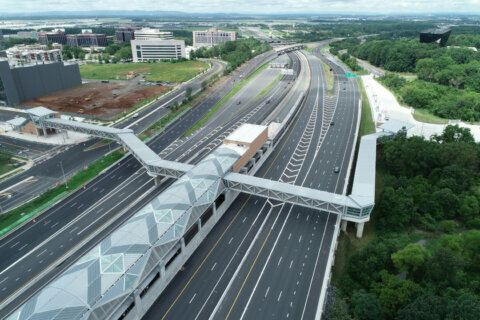This article was republished with permission from WTOP’s news partner InsideNoVa.com. Sign up for InsideNoVa.com’s free email subscription today.
This article was written by WTOP’s news partner InsideNoVa.com and republished with permission. Sign up for InsideNoVa.com’s free email subscription today.
Manassas Police are set to begin identifying intersections that will ultimately receive red light cameras after the city council approved an ordinance allowing their use Monday night.
The ordinance calls for the city to install enforcement cameras at problem intersections based on accident rates, the frequency of red light violations and the possible difficulty faced by law enforcement in stopping offenders. An automated ticketing process will issue fines of up to $50 for running a red light, though the system will grant a half-second grace period for vehicles entering the intersection just after the light turns. The ordinance passed by a 5-1 vote, with Council Member Ian Lovejoy (R) providing the only vote in opposition.
Chief of Police Douglas Keen said that 10 intersections will be studied to see if they’d be suitable for a camera. According to police statistics, the three most crash-prone intersections in the city in 2018 were all along Liberia Avenue (at Centreville Road, Euclid Avenue, Mathis Avenue and Signal Hill Road), with Keen noting that Liberia and Centreville would be “priority number one” for study.
“Our goal here is to reduce dangerous behavior at the most troubled intersections here in the city of Manassas,” Keen said. “Traffic enforcement is the biggest request I get from our citizens.”
For 30 days immediately preceding the systems implementation police will be handing out warning tickets and a “conspicuous” sign will be placed within 500 feet of every selected intersection alerting drivers to the system, as mandated by the ordinance.
Representatives from the chosen vendor, New Jersey-based Conduent, said that Virginia law mandates red light cameras only capture photos and video from a vehicle’s rear end, and that no images of a driver’s face would be taken.
Supporters of the program hope that the cameras will make dangerous intersections safer for everyone — drivers, pedestrians and cyclists alike.
“I was surprised it’s taken them so long to ask for an ordinance for red light cameras, quite frankly,” said Allen Muchnick, a Manassas resident and board member of Active Prince William, an advocacy group pushing for increased road safety. “Traffic enforcement needs to be automated. Our traffic laws in general are under-enforced and you can see widespread red-light running.”
According to their 2018 annual report, Manassas City police responded to 631 “reportable” crashes last year, up seven percent from 2017. Forty-three of those crashes were the result of drivers disobeying traffic signals, police said. All told, MCPD issued 200 citations for disobeying traffic signals.
The use of red-light cameras has been legal in Virginia since 2007, and 10 localities currently have them. Nearby Fairfax City has cameras at six intersections, Arlington has nine and Alexandria four. But eight states have also outlawed their use, and critics say they don’t actually reduce the number of accidents at intersections.
A 2017 Case Western Reserve University study of the cameras in Texas (where they have since been banned) found that while the number of “angle” collisions in intersections fell, the number of rear-end collisions increased as drivers were more likely to brake harder. The study did not rule out the possibility, however, that accidents before red light cameras were implemented were more severe. Speed, it said, is a more important factor in intersection safety, but in Virginia the state legislature has so far rebuffed efforts to allow localities to use automated speed enforcement cameras.
But Keen said that severe accidents have been reduced drastically in other Virginia localities that have implemented the red light cameras, telling the council that within three years of their installation in Fairfax City, affected intersections saw a nearly 50% drop in both accidents and citations.







